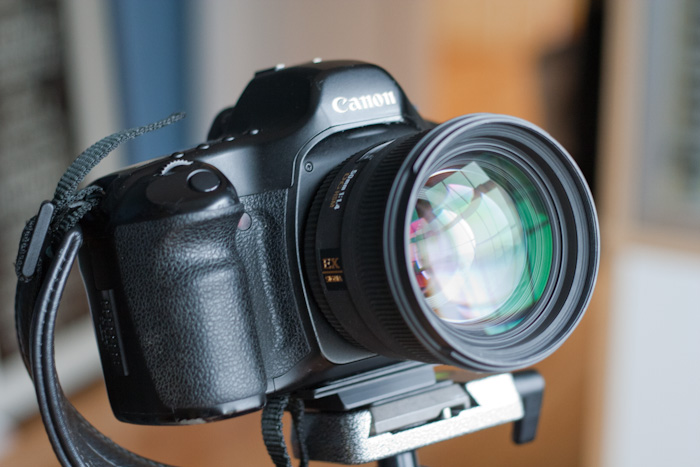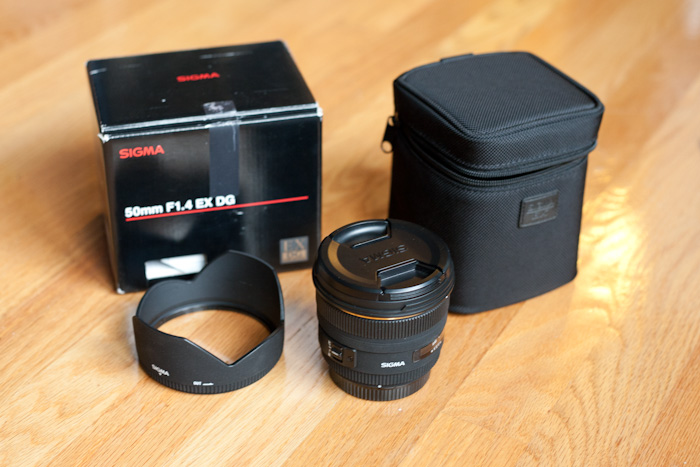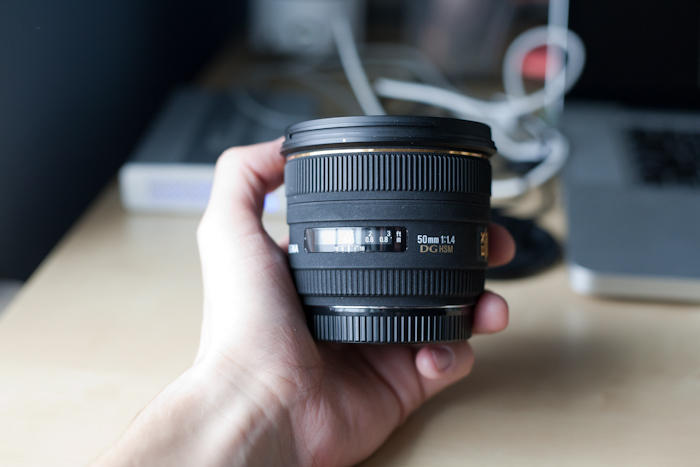My first lens review with The Phoblographer was on the Sigma 85mm f/1.4. I truly enjoyed shooting with that lens and if I was in the market for an 85mm prime, Sigma would get my money. An 85mm lens is great for portraits but I, like many other people, find 50mm to be a more useful focal length for everyday shooting. Luckily for me, Sigma offered to lend me the 50mm f/1.4 EX DG HSM to test out. If this performs as good as its 85mm sibling, my wallet may be lighter by the end of this review.
Tech Specs
- Lens Construction: 8 elements in 6 groups
- Angle of view: 46.8*
- Number of Diaphragm Blades: 9
- Minimum Aperture: f/16
- Minimum Focusing Distance: 45 cm / 17.7 in
- Filter Size: 77mm
- Maximum Magnifications: 1:7.4
- Dimensions (Diameter x Length): 84.5 x 68.2 mm/3.3 x 2.7 in
- Weight: 505g / 17.8oz.
- Available in mounts for the following manufacturers: Canon, Sigma, Sony, Nikon, Pentax
LENS CONSTRUCTION

What’s Included
Unlike Canon’s mid-range lenses, Sigma gives you more than just the lens and a few caps. Included with the lens is a zippered soft case which actually feels like it would do a solid job of keeping your lens safe. On top of that, Sigma includes a lens hood. Yay! I hate when you drop several hundreds of dollars on a lens and the manufacturer doesn’t even throw in a lens hood. Finally, one of the most important items in the box is the warranty registration card. Because this is an EX lens, it is covered for a total of 4 years which is quite good.
Look and Feel
The Sigma 50mm f/1.4 is a mixed bag when it comes to look and feel, there is some good and some bad. Let’s start with the good. The outside of the lens has a flat black finish which has a slightly rough texture. This texture feels good in your hand and provides additional grip. Now, let’s talk about that big, beautiful chunk of glass. The front element is massive and looks great when mated to my Canon 5D, I could stare at it for hours. One thing I love about this lens is how the front element is recessed into the barrel of the lens. It’s almost like the lens has a built-in mini hood. I’m always worried about smacking the front of my lens into things, which is why I use filters on my L glass, but because the front element is recessed, I probably wouldn’t put a filter on this lens. Also, the weight of the lens is right in that sweet spot, heavy enough to feel quality and well made but not so heavy that it would feel like a burden to carry.
OK, on to the bad. Luckily, I only have one real complaint about the look and feel and that is the focus ring. To be quite honest, it just feels crude. It’s tough to turn and the resistance does not have a linear feel. Start turning and you feel the ring slowly grind it’s way into focus. As you turn your way from on stop to the other you will hit a few spots where it becomes easier to turn. This makes focusing in a smooth and consistent manner very difficult, videographers beware. The last lens I tested was the Zeiss 35mm f/1.4. You want to talk about a well made and perfectly weighted focus ring? That thing is like butter. Zeiss knows what they are doing with focus rings.
Currently, the Sigma 50mm f1/.4 EX DG HSM comes in at just under $500 (for all mounts) which is VERY close to Canon’s 50mm f/1.4 offering. Overall, I would say that this lens has a better build quality than Canon’s 50mm f/1.4. It it’s definitely no L lens but we shouldn’t expect it to be at this price.
General Observations
My 50mm is basically glued to my Canon 5D, so I felt right at home using the Sigma 50mm f/1.4. This lens feels like it was designed for the 5D, it just feels so balanced. With the Sigma 50mm weighing in at over a pound, the 5D and the Sigma are not the lightest rig but I walked around for hours with this combo without any issues and all I used was a hand strap. The Sigma 50mm f/1.4 will feel great when mated to a larger bodied camera (e.g. Canon 5D or Canon 7D), but it still feels surprisingly good when combined with a smaller body, consumer camera. It does feel slightly front-heavy on smaller cameras (e.g. my Canon Rebel XT) but the lens is fairly compact so the weight stays close to the body of the camera. With that being said, you need to take the crop factor into consideration if you’re using a camera with an APS-C sized sensor. If you do have a crop body camera, Sigma has a few other fast primes (e.g. Sigma 30mm F1.4 EX DC HSM) that will give you close to a 50mm field of view.
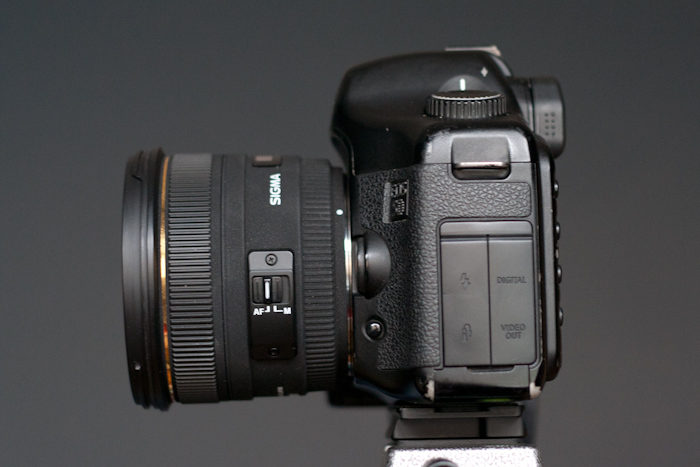
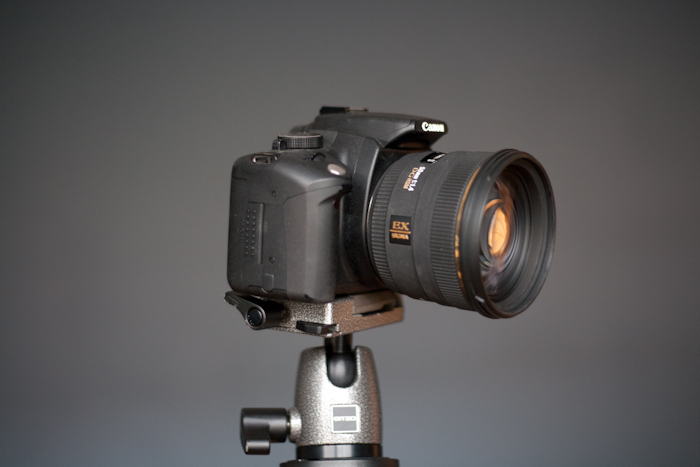
One funny thing about the Sigma 50mm is it does not exactly have a 50mm field of view, it’s actually only 46.8*. This doesn’t bother me at all and I would honestly rather have the field of view be a little wider than tighter. I only noticed a difference when I put the camera on my tripod and switched between the nifty fifty and the Sigma, I wouldn’t have noticed a difference otherwise.
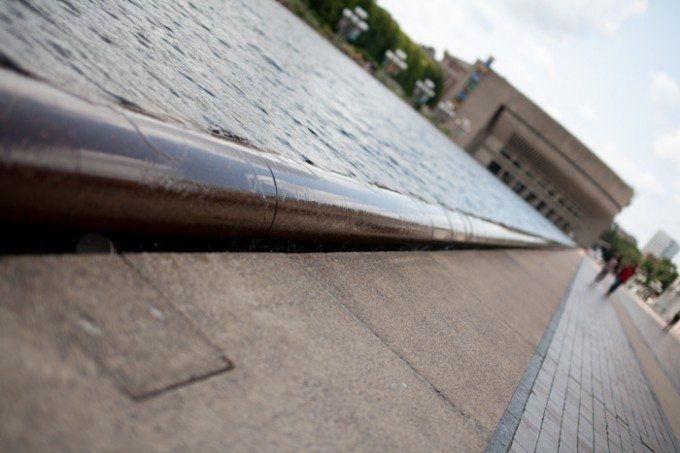
Lightroom users will be happy to know that there is a pre-installed lens profile for the Sigma 50mm f/1.4. From what I can tell, it looks like the lens profile corrects for vignetting and distortion but both adjustments are pretty minor. I actually enjoy a slight vignetting on most of my images but it’s nice to know I can simply check off a box and get a nice, clean, straight image without having to do a lot of tweaking.
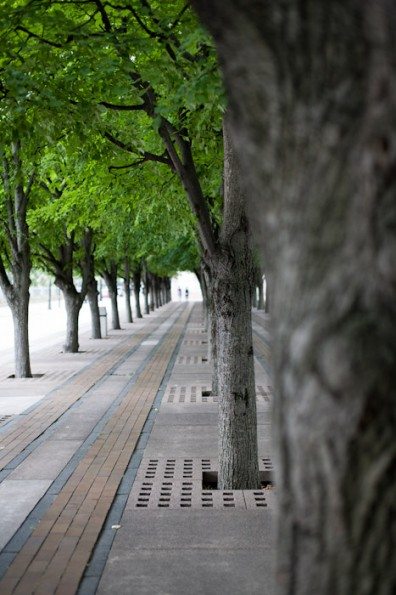
Auto Focus Speed
For me, the biggest issue with this lens is the AF speed. It’s not that it’s slow to the point of not being useful and it’s not inaccurate at focusing, it’s just that you would expect a lens of this price to focus a bit faster. Check out the video below comparing the Sigma 50mm f/1.4 to the Canon f/1.8. The Sigma does this strange thing where it snaps to focus and then it does a little fine tuning before it confirms focus. That little shimmy at the end is the difference between the Canon and the Sigma. The difference isn’t huge, but I would like to see the lens that costs four times as much as the other to have a little more pep. I understand that the Sigma has more glass to move, but I have other lenses with a lot more glass than the Sigma that absolutely destroys it in AF performance. Now, do I think this is a big deal? No, not in the least bit but someone that needs to have lightning quick AF may disagree with me. I mostly shoot street, lifestyle and landscapes and while fast AF is good, I can live with the Sigma’s speed.
Remember the video down below is just for reference.
Focusing Accuracy
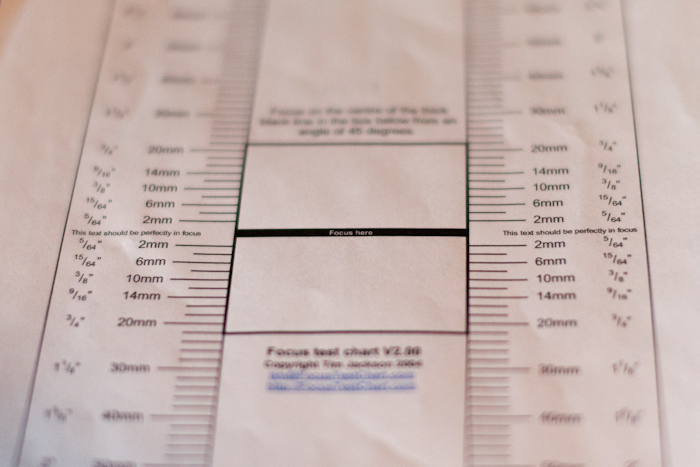
If you’ve done any research on Sigma 50mm f/1.4 in the past, I’m sure you’ve read about the front/back focusing issues that plagued the early versions of this lens. Since then, Sigma has supposedly rectified the issue and things seem to be better. Based on customer reviews on sites like B&H Photo and Amazon, it looks like Sigma truly did fix their manufacturing issues. You still hear of the occasional problem so I wanted to test this lens for myself. As you can see from the photo above, it looks like I have a good copy. If you do get a bad copy, Sigma will calibrate your lens to your camera for free provided it is under warranty.
Image Quality

I was truly impressed with the Sigma 50mm‘s performance; there is really very little to complain about. To keep things simple and easy to process, I’ve broken down some key traits that most lenses are judged upon, see below:
Bokeh: This is where the Sigma really kills the competition. Besides the Canon 50mm f/1.2L, I don’t think bokeh in this focal length gets better than this. Yes, the Zeiss 50mm f/1.4 has “unique” bokeh, but I think most photographers prefer the Sigma’s super smooth and creamy bokeh. Also, thanks to the 9 bladed diaphragm, bokeh balls are nice and round, no hexagons here.


Flare: With it’s recessed front element and included hood, I was actually surprised as how easy it was to get this lens to flare. Granted, I was trying to get the lens to flare, but I don’t recall it being this easy with the Sigma 85mm f1/.4. Regardless, flare was not an issue during normal shooting situations, just treat it like you would any other lens when shooting in situations where flare could be an issue.
Chromatic Aberration: Like the Sigma 85mm f/1.4, CA is present when shooting at wider apertures. As is the case with most lenses, as you stop down CA will become less of an issue. By f/2.8 or f/3.2 CA is not an issue. Most color fringing I encountered could be cleaned up in post processing with very little effort.
Sharpness: Not surprisingly, the more you stop down, the better your results (up to about f/8). At f/1.4 the lens is slightly soft, even in the middle of the frame. I personally do not consider the images unusable, but they are noticeably soft, especially when compared to the same image shot at f/2 or higher. At f/4 this lens is so sharp your eyes will bleed.


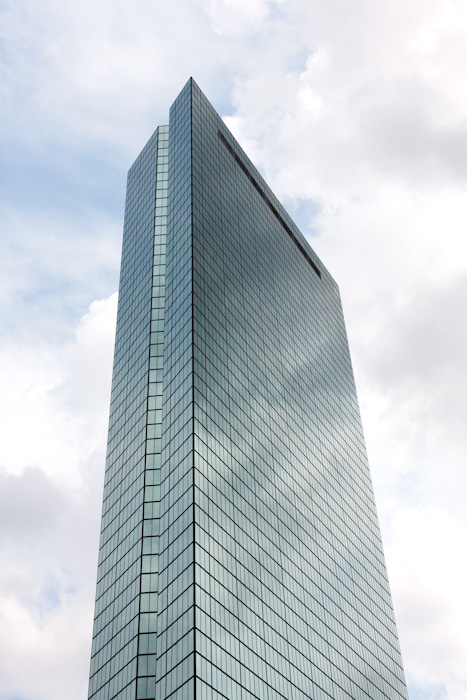
Vignetting: The ginormous front element of the Sigma 50mm f/1.4 is designed to minimize vignetting on full frame sensors. While vignetting is preset at wider apertures, it is not something I would call an issue. Plus, vignetting is one of the easiest things to fix in post process.
The Good
- Bokeh from this lens is hard to beat with any lens regardless of price.
- Very sharp at apertures smaller (larger f number) than f/2.
- Feels very balanced on larger camera bodies.
- Excellent build quality minus the focusing ring.
- Case and lens hood included.
- Overall image quality is hard to beat for a lens under $500
The Bad
- Weight, this lens does weigh over a pound. Most 50mm lenses are compact and fairly light but don’t let the weight deter you from buying this lens. I shot with this lens for about four hours straight and I held the camera in one hand the entire time. While you definitely won’t forget that it’s there, it’s not fatiguing to carry this lens around for extended periods of time.
- The focusing ring is really very crude. If you shoot video or prefer to focus manually, you are going to be disappointed.
- Auto Focus is on the slower side. As you can see from the video above, it’s not so slow that it’s unusable, I simply want to make it known that the Sigma’s AF is not in the same class as Canon’s 50mm f/1.4. Personally, this is not a big deal for me but this may be a deal breaker for others.
Who is it for?
Honestly? I think every photographer should own a 50mm lens. This focal length is so flexible and the lenses at this focal length are usually cheaper than their wider or more telephoto siblings. With the Sigma 50mm f/1.4 coming in at just under $500, this lens is probably one of the best values in photography at the moment. Whether you shoot on the street, take portraits, shoot landscapes or simply want a good all-around lens, this lens has to be on your short list.
Conclusion

As you can see from the sample images, the Sigma 50mm f/1.4 is a real performer. At f/2 and above it is very sharp and the bokeh it produces is simply stunning. The only real limitations with the Sigma are the focusing ring and the AF speed. For those of you that rely on or prefer manually focusing, I’d go for the Zeiss. While the Zeiss isn’t optically perfect wide open, I really enjoy it’s unique characteristics and its focusing ring is second to none. If AF speed is of the up most importance, I would probably go for the Canon 50mm f/1.4. While the difference in speed is not drastic, it is noticeable and for some AF speed is critical. If you don’t need blisteringly fast AF focus and you could care less about the crude focusing ring, I think the Sigma 50mm f/1.4 is the 50mm to have.

Please Support The Phoblographer
We love to bring you guys the latest and greatest news and gear related stuff. However, we can’t keep doing that unless we have your continued support. If you would like to purchase any of the items mentioned, please do so by clicking our links first and then purchasing the items as we then get a small portion of the sale to help run the website.



